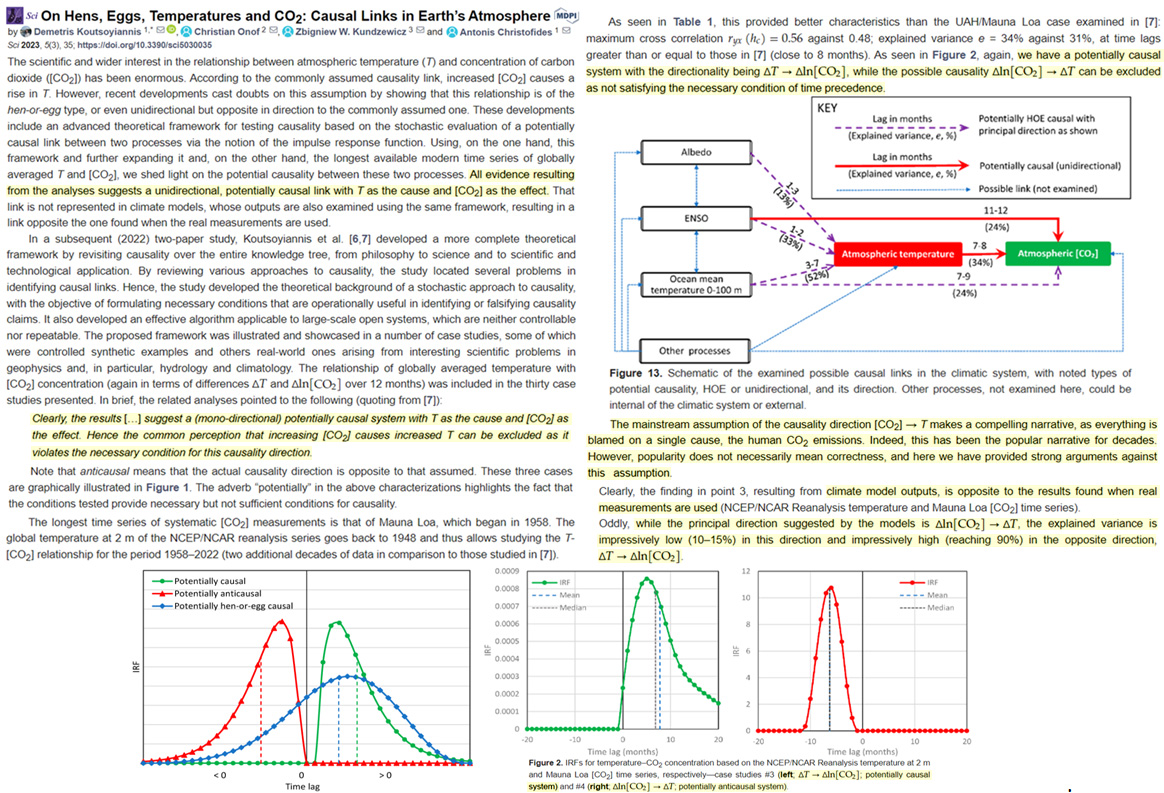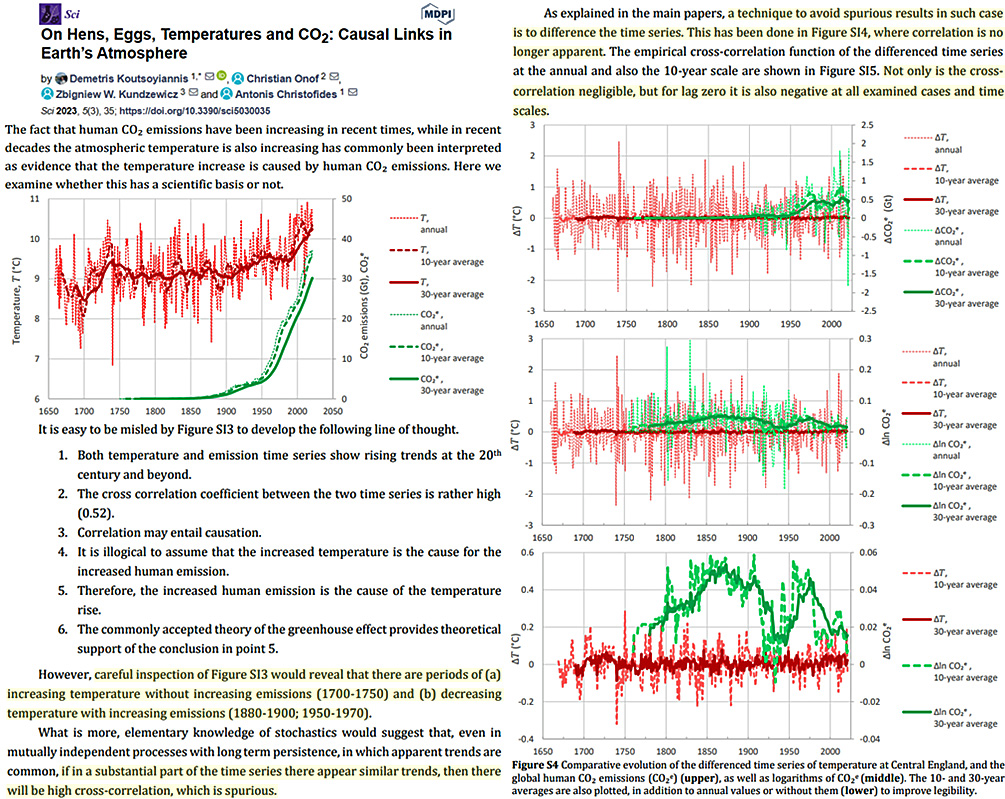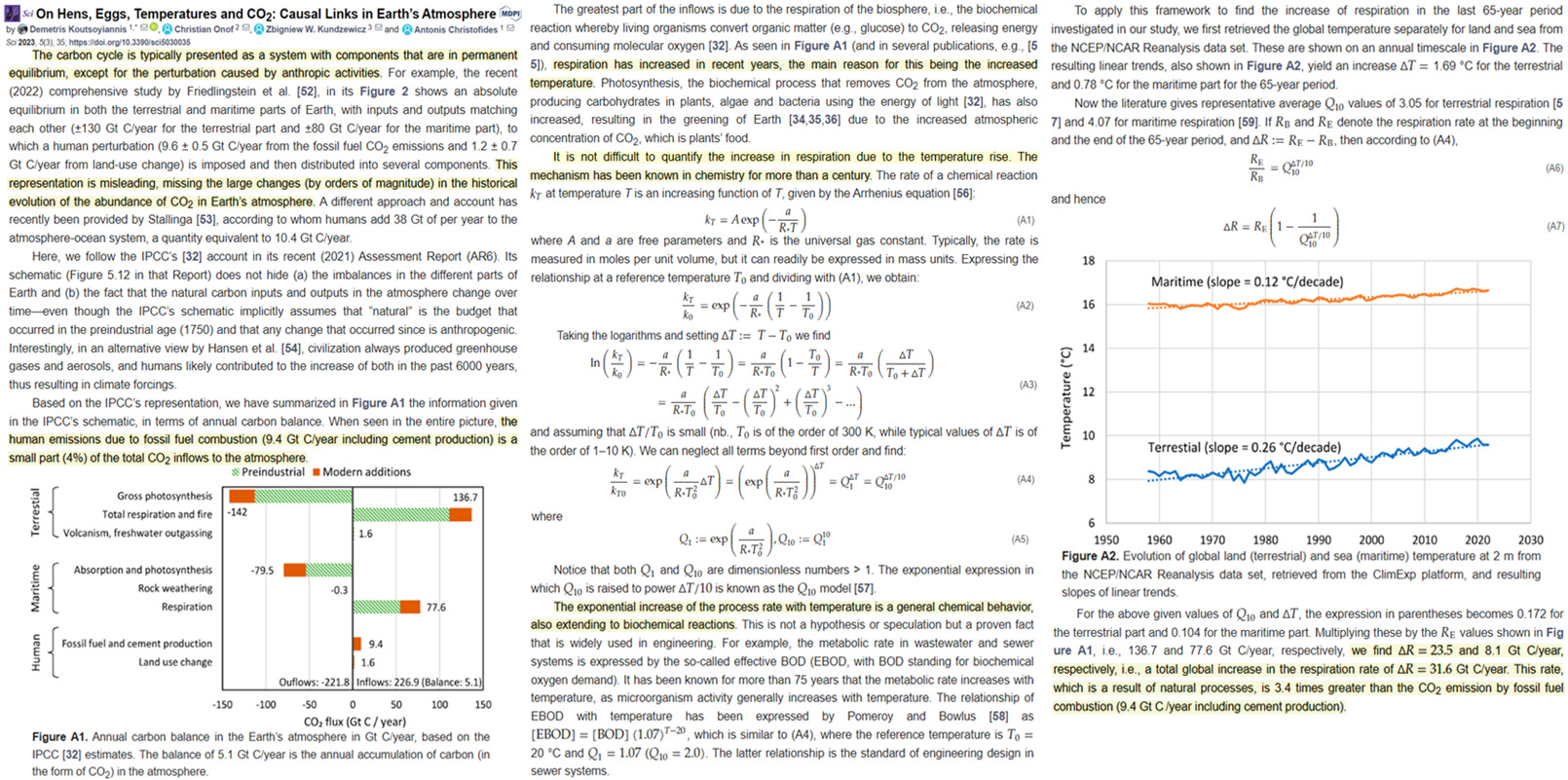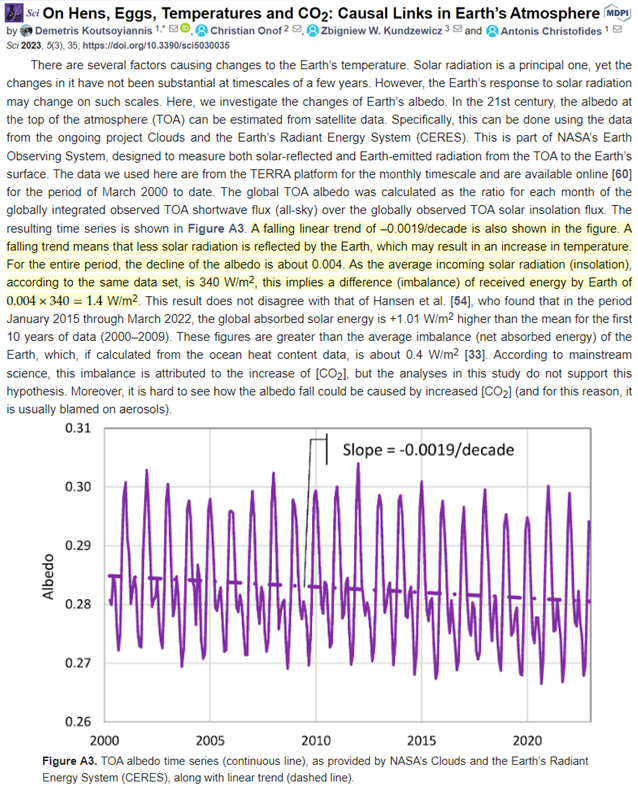“Oddly, while the principal direction suggested by the models is ΔIn[CO₂] → ΔT, the explained variance is impressively low (10-15%) in this direction and impressively high (reaching 90%) in the opposite direction, at ΔT → ΔIn[CO₂].” − Koutsoyiannis et al., 2023
One of the most basic concepts in physics is that causes precede effects and effects follow causes. Determining the directionality sequence is thus essential in any causality analysis.
The assumed CO₂→T causality direction cannot be scientifically supported
The assumption in climate models is that CO₂ causes changes in temperature, or T. More specifically, it is assumed modern global warming has been caused by increases in anthropogenic CO₂ emissions.
However, scientists (Koutsoyiannis et al., 2023) have now expanded upon last year’s 2-part study on stochastics-formulated causality published in The Royal Society (Koutsoyiannis et al., 2022 (1) and Koutsoyiannis et al., 2022 (2)) where they notably contend:
“Clearly the results […] suggest a (mono-directional) potentially causal system with T as the cause and [CO₂] as the effect. Hence the common perception that increasing [CO₂] causes increased T can be excluded as it violates the necessary condition for this causality direction.”
A year later these same authors have again conspicuously demonstrated the assumed CO₂→T causality direction cannot be scientifically supported because observations clearly show that variance in T leads or precedes growth rate variance in CO₂ by 6 or more months.
“All evidence resulting from the analyses suggests a unidirectional, potentially causal link with T [temperature] as the cause and [CO₂] as the effect.”
Observational evidence overrules modeled assumptions, regardless of how compelling or mainstream the conventional wisdom.

Image Source: Koutsoyiannis et al., 2023
Cross-correlation analysis reveals CO₂-causes-warming trend alignment depictions are spurious
Because it is widely assumed human CO₂ emissions are the cause and temperature changes are the effect, tendentiously adjusting the axes on graphs to make it appear that the CO₂ and T trends align (i.e., curve-fitting, as shown in the left-side chart below) has become a popular pursuit for those advancing the anthropogenic global warming narrative.
It can be shown, however, that these trend alignments are spurious. Why? Because in the industrial era there have been periods when temperatures have risen rapidly with negligible CO₂ emissions (1700-1750), and decreasing temperatures while CO₂ emissions were rising (1880-1900, 1950-1970). When including all these counter-alignments together and differencing the time series (cross-correlation), the CO₂→T trend alignment disappears. These non-correlations are clearly shown in the right-side charts below. If there are non-correlations, or if the correlations are spurious, causation cannot be established.

Image Source: Koutsoyiannis et al., 2023
Natural CO₂ emissions induced by warming can be shown to be responsible for rising CO₂ concentrations
Fossil fuel emissions amount to 9.4 GtC/year, which is only 4% of the total CO₂ emissions from all sources. In contrast, nature (respiration, freshwater outgassing, fire, volcanism, etc.) produces CO₂ emissions amounting to 216 GtC/year.
It is assumed that the carbon cycle is, in its natural state (without human interference), in perpetual equilibrium, with emissions from natural sources almost perfectly balanced by natural sinks. This presumption is flawed, however, because nature’s sinks don’t decide to only absorb the 216 GtC/year from natural sources as they simultaneously fail to absorb the 9.4 GtC/year from human activities. The 216 GtC/year from nature and 9.4 GtC/year from fossil fuels are instantaneously combined, and nature’s sinks absorb emissions proportionately from the total, ~225 GtC/year.
In their new paper’s appendix, Koutsoyiannis and colleagues have used basic chemistry to show that outgassing from warming and respiration can be biochemically shown to produce emissions rates of 31.6 GtC/year. This is 3.4 times more than the annual emissions from fossil fuels (9.4 GtC/year). Thus, the observation that temperature may potentially a cause of rising CO₂ concentrations appears to be observationally supportable. A substantial portion of modern CO₂ rise may thus be natural.

Image Source: Koutsoyiannis et al., 2023
Natural mechanisms for warming may include the natural increase in sunshine duration
If rising CO₂ concentrations cannot explain modern warming due to the violation of the requisite causality direction, what can?
As has been detailed extensively in many other observational studies, the recent decline in Earth’s planetary albedo (clouds, aerosols) has been reflecting less solar radiation and increasing sunshine duration in recent decades. This, in turn, warms the surface.
A 0.01 change in planetary albedo can induce a radiative forcing of ±3.4 W/m² (Wielicki et al., 2005).
Koutsoyiannis and colleagues cite CERES data that depict a falling linear trend of -0.0019 per decade in planetary albedo since 2000. This can be shown to have elicited a +1.4 W/m² positive imbalance from incoming shortwave, which is sufficient to explain the modern radiative forcing associated with rising temperatures.
So the warming in recent decades may be natural. The CO₂ increases resulting from the natural warming may be substantially natural too. And these results are observationally supportable.
Given the evidence presented in this new study, the claim that human CO₂ emissions are the cause of modern warming is not observationally supportable.






[…] Related: New Study: The Rising-CO2-Causes-Warming Perception Not Supported By Real-World Observation […]
Excellent and very relevant. It confirms a series of articles with similar results. You can see it visually at: Ole Humlum, Kjell Stordahl, and Jan-Erik Solheim: “The phase relation between atmospheric carbon dioxide and global temperature.” Global and Planetary Change Vol. 100, p. 51 (2013) at https://www.sciencedirect.com/science/article/abs/pii/S0921818112001658 and
https://www.researchgate.net/publication/257343053_The_phase_relation_between_atmospheric_carbon_dioxide_and_global_temperature.
That seems to fit with this: https://theethicalskeptic.com/2020/02/16/the-climate-change-alternative-we-ignore-to-our-peril/
It is very easy to understand why so-called greenhouse gases cannot have the slightest effect on the temperature of the earth’s surface. Look here: https://qblog-rcli.netlify.app/posts/gaz-effet-serre-en/
This is what Salby, Harde and Berry have been saying for several years. This analysis adds a new depth and perspective to their work. There are no serious efforts to defeat their work that I know of.
[…] on tuore artikkeli (Linkki), jossa esitellään Koutsoyiannisin ja kumppaneiden tutkielmaa pintalämpötilan ja […]
[…] – New Study: The Rising-CO2-Causes-Warming Perception Not Supported By Real-World Observation […]
[Koutsoyiannis et al., 2023] is wrong.
Their first error is his naive belief that the fact that temperature changes affect CO2 levels means that CO2 levels cannot affect temperatures. Actually, the fact that temperature changes affect CO2 levels means that CO2 levels tells us nothing at all about the effects of CO2 levels on temperatures.
In a hypothetical universe in which rising temperatures cause rising CO2 levels, and rising CO2 levels cause falling temperatures, that would constitute a “negative feedback loop.”
In the real world, in which rising temperatures cause rising CO2 levels, and rising CO2 levels cause rising temperatures, that constitutes a “positive feedback loop” (albeit a weak one).
You can learn about feedback loops here:
https://sealevel.info/feedbacks.html
[Koutsoyiannis et al., 2023]’s second error is their contention that natural CO2 emissions, rather than anthropogenic emissions, are responsible for rising CO2 concentrations. It is silly to speculate about that, because we have the data which proves that mankind is adding CO2 to the atmosphere, and nature (which is to say, the net sum of all natural sources and sinks) is removing it.
Obviously, removing CO2 from the atmosphere (which is what natural fluxes are doing) does not increase the amount of CO2 in the atmosphere.
You can learn about that here:
https://sealevel.info/carbon/carbonflux.html
and here:
http://www.ferdinand-engelbeen.be/klimaat/co2_origin.html
and here:
https://sealevel.info/atmospheric_co2_increase_is_not_from_ocean_outgassing.html
“[Koutsoyiannis et al., 2023] is wrong.”
Nice to meeting you, professor Burton!
I did not write that Koutsoyiannis et al expressed a naive belief that the fact that temperature changes affect CO2 levels means that CO2 levels cannot affect temperatures. That’s Kenneth Richards’ error.
Koutsoyiannis et al make a slightly different mistake. They’re befuddled by short term fluctuations in CO2 levels, which are caused by natural factors. They think the phase relation between temperature and CO2 level fluctuations implies that temperatures drive CO2 level.
That’s wrong. When periodic variations of different things are correlated, it is always a mistake to draw conclusions about causality without considering the underlying mechanisms — which Koutsoyiannis et al unfortunately ignore.
As it happens, the reason for the short term correlation between CO2 levels and temperature levels is obvious, and it does not imply causality in EITHER direction.
Although CO2 and temperature do affect each other, those effects are too slight to significantly contribute to the observed short term correlation between them. Instead, the correlation is caused by the fact that both CO2 levels and temperature levels are affected by sunlight.
Increased sunlight during spring and summer obviously raises regional temperatures. It also also causes plant growth, which removes CO2 from the air, reducing CO2 levels. Conversely, reduced sunlight during fall and winter lowers temperatures, and causes leaves and grasses to rot and release CO2, raising CO2 levels.
So the phase-offset seasonal correlation between CO2 and temperature does not imply causality in EITHER direction. Instead, the correlation is caused by the fact that both are affected by sunlight.
We know from the physics of the (poorly named) “greenhouse effect” that rising CO2 levels have a warming effect. You can learn about it here:
https://sealevel.info/learnmore.html#physics
We also know from the temperature dependence of Henry’s Law that temperature changes slightly affect atmospheric CO2 levels, though that effect is dwarfed both by accelerated natural CO2 removals as CO2 levels rise, and by anthropogenic CO2 emissions.
The fact that temperatures and CO2 levels affect each other makes the relation between them a feedback loop, but it’s a very weak one.
I didn’t write “CO2 levels cannot affect temperatures”. Instead, the observational results reported in Koutsoyiannis et al. (2020, 2022 and 2023) pertaining to the causality directionality (T→CO2) do not support the claim that anthropogenic CO2 emissions are the cause of variations in temperature.
Furthermore, your claim that Koutsoyiannis et al. are “befuddled by short term fluctuations in CO2 levels” is also not supported by the evidence presented in their papers. They are hardly befuddled. Perhaps you should consider their invited commentary on Judith Curry’s blog: https://judithcurry.com/2023/09/26/causality-and-climate/
Perhaps you should be more careful to avoid misrepresenting what others have to say.
[…] is a pdf copy of this significant paper. The original is here. No Tricks Zone and Judith Curry also reviewed this […]